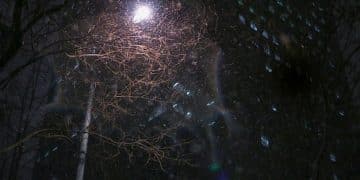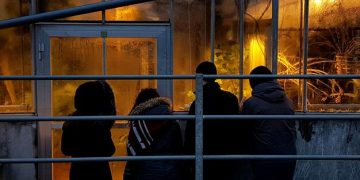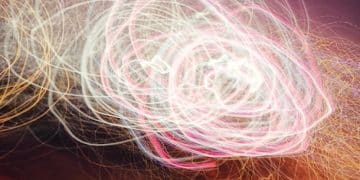The Future of Paranormal Research: New Tech in Next 5 Years

The future of paranormal research is poised for a technological revolution, with advancements like enhanced sensors, AI-driven analysis, and virtual reality environments promising to unveil unprecedented insights into unexplained phenomena over the next five years.
The realm of paranormal research stands on the cusp of a transformative era. The future of paranormal research: what new technologies will uncover in the next 5 years? is set to redefine how we investigate and understand phenomena that have long eluded conventional scientific explanation. This fusion of cutting-edge tech and age-old mysteries promises to shed light on the unknown in ways never before imagined.
Advancements in Sensor Technology
Sensor technology is undergoing rapid evolution, promising increasingly sensitive and sophisticated data collection for paranormal investigations. These improved sensors could expose anomalies we couldn’t detect before.
More accurate and sensitive sensors are on the way, including electromagnetic field (EMF) meters, infrared cameras, and acoustic sensors, and will likely reveal subtle energy signatures and environmental changes linked to paranormal events, leading to more credible evidence.
Enhanced EMF Meters
Enhanced EMF meters will precisely measure electromagnetic fields, useful in detecting unusual fluctuations that can indicate paranormal activity. Refinements in calibration and shielding will eliminate false positives.
Advanced Infrared Cameras
Advanced infrared cameras will allow for capturing clearer thermal images, making it easier to identify temperature anomalies that might point to paranormal presences. Higher resolutions and better thermal sensitivity will improve the precision.
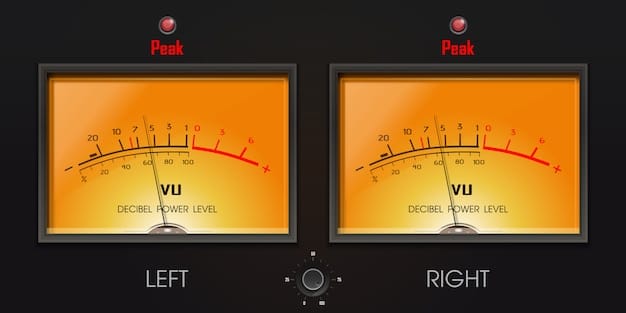
- Improved sensitivity to subtle EMF variations.
- Real-time data analysis, alerting instantly to anomalies.
- Integration with other sensors for a complete environmental profile.
In conclusion, advances in sensor technology promise a more precise and comprehensive approach to paranormal investigations, paving the way for more credible evidence gathering. Improved EMF meters, infrared cameras, and acoustic sensors will work together to reveal previously undetectable paranormal indicators.
The Role of Artificial Intelligence
Artificial intelligence (AI) is poised to revolutionize data analysis in paranormal research, enabling the identification of patterns and anomalies that would be impossible for humans to detect manually. AI algorithms will be able to scour through massive amounts of data and may reveal connections we never considered.
AI algorithms are increasingly sophisticated and can sift through immense datasets collected during paranormal investigations. These datasets often comprise audio recordings, video footage, sensor readings, and environmental data. AI can identify patterns, correlations, and anomalies indicative of paranormal activity with far greater speed and precision.
Automated Data Analysis
AI can automate the tedious task of data analysis. It can quickly process audio and video, identifying anomalies that a human might miss. AI can also cross-reference sensor data with environmental conditions to find correlations.
Predictive Modeling
Predictive modeling uses AI to forecast when and where paranormal events are most likely to occur. By analyzing historical data, AI can identify variables that may trigger activity. This could help researchers to be in the right place at the right time.
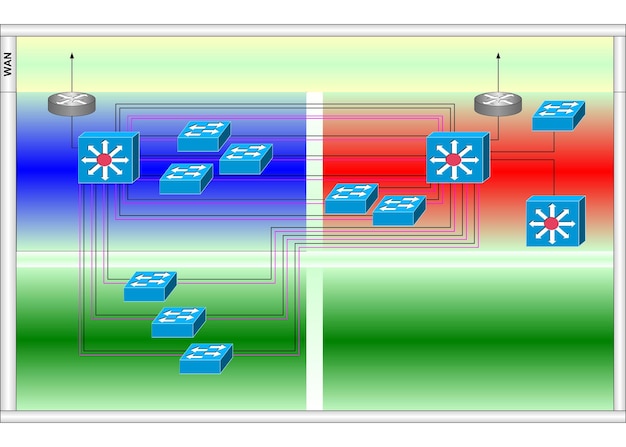
- Identifying subtle patterns imperceptible to human observers.
- Eliminating the risk of human biases in data interpretation.
- Offering objective, data-driven insights.
In conclusion, AI offers unparalleled potential to transform the world of paranormal research, uncovering insights and patterns that would otherwise remain hidden. Automated data analysis, voice and image recognition, and predictive modeling are just a few examples of how AI can enhance our understanding of the unexplained.
Virtual Reality and Simulated Environments
Virtual reality (VR) offers new ways to study paranormal phenomena. VR can create controlled environments that allow researchers to study how individuals experience hauntings. It also offers ethical ways to investigate phenomena without disturbing real locations.
VR and simulated environments offer controlled, ethical ways to study paranormal experiences. By creating highly realistic, repeatable scenarios, researchers can observe how participants react to various stimuli in a safe setting. This technology allows for systematic investigation and the isolation of variables.
Controlled Experiments
VR enables researchers to design experiments that can be replicated. Researchers can study how people respond to different stimuli such as apparitions or paranormal sounds. Such control enables statistical analysis.
Ethical Considerations
VR addresses ethical concerns by avoiding disturbance of actual locations. Investigators can examine historically haunted sites without the danger of causing damage. Subjects can be exposed to simulated paranormal experiences without being put at actual risk.
- Studying the psychology of paranormal belief in controlled conditions.
- Implementing real-time physiological monitoring during experiments for objective data.
- Testing different intervention strategies in a risk-free setting.
In conclusion, VR and simulated environments are changing how paranormal research is done, providing possibilities for controlled experiments, ethical assessments, and realistic, immersive experiences. VR helps researchers unravel the mysteries of paranormal events, advancing our scientific knowledge and understanding of the unexplained by enhancing the data collection, experimentation, and ethical standards of paranormal research.
Geospatial Analysis and Mapping
Geospatial analysis enhances paranormal research, revealing spatial patterns and environmental correlations. By pinpointing paranormal hotspots and considering geographical factors, researchers gain new insights.
Geospatial analysis and mapping tools are being used to examine the spatial distribution of paranormal events, helping identify geographical correlations and potential environmental factors contributing to the activity. Incorporating geographic data into paranormal studies allows researchers to see broader trends, maybe exposing patterns they have not seen before.
Identifying Hotspots
Using mapping technologies, researchers can pinpoint areas with frequent paranormal reports. Clusters of events can reveal hotspots or corridors of activity, thus focusing investigative efforts. Mapping techniques can overlay historical data, physical locations, and environmental features.
Environmental Correlations
Geospatial analysis can link paranormal reports with environmental elements, such as geological fault lines, bodies of water, or ancient sites. Recognizing these interconnections could provide understanding concerning the underlying reasons for unexplained phenomena.
- Correlation analysis between geographical features and reported paranormal occurrences.
- Predictive models focused on identifying high-probability locations.
- Visual representation for stakeholders and the public.
Geospatial analysis and mapping provide unique investigative prospects, integrating spatial understanding with paranormal phenomena. Recognizing hotspots, environmental interconnections, and predictive modeling brings another layer of analysis to understanding and exploring paranormal activity. Such methods guarantee that researchers are better equipped to evaluate and decipher the puzzles of the paranormal world.
Advancements in Audio Analysis
Audio analysis is becoming more precise, allowing researchers to identify a broader specturm of anomalies in recordings. AI, algorithms, and refined sound filtering remove interference while highlighting potential EVP.
Advanced audio analysis techniques are improving the detection and interpretation of auditory anomalies, such as Electronic Voice Phenomena (EVP). Sophisticated algorithms filter out background noise, enhance faint sounds, and analyze audio patterns to identify potential paranormal communications. These advancements clarify the noises.
EVP Enhancement
New tools help to isolate, clarify, and interpret EVPs. Algorithms reduce noise and highlight human-like sounds that might indicate paranormal communications. The enhancement means hearing what might otherwise be unheard.
Real-time Analysis
Real-time audio analysis is now a reality. Researchers can analyze sounds as they are being captured and make on-the-spot decisions about their investigations. Real-time data helps researchers immediately identify and react to possible instances of paranormal activity.
- Refined algorithms optimized for EVP detection and analysis.
- Tools to filter out environmental and electronic interferences.
- User interfaces for ease of use by paranormal investigators.
Advanced audio analysis is transforming paranormal investigation, improving the precision and depth of audio data interpretation. EVP enhancement, real-time analysis, and spectral analysis are invaluable instruments in the quest for evidence of paranormal events. Improving sound recording and assessing could potentially expose paranormal mysteries within the audio realm providing investigators with critical knowledge into paranormal phenomenon.
The Ethics of Paranormal Research
Ethical issues in paranormal research are more crucial than ever before. As technology improves, researchers must tackle the effect on participants, guarantee anonymity, and respect potentially sensitive locations.
The ethical dimensions of paranormal research are gaining increased attention as technology advances. Protecting participants from psychological distress, ensuring the privacy of individuals and locations, and respecting cultural sensitivities are vital. Ethical protocols guarantee that paranormal investigations are performed responsibly and respectfully.
Informed Consent
Acquiring participant’s informed consent is vital. Investigators should outline the intentions of the investigation, any achievable dangers, and the safeguards implemented to safeguard their interest. Individuals need to have the authority to leave from research at any moment.
Data Privacy
Protecting data privacy and anonymity is critical. Investigators have to anonymize data, securely store, and comply with all relevant privacy rules. Getting participant’s trust and maintaining standards of accountability are key.
- Review and adjustment methods for ethical guidelines.
- Training programs for investigators on ethical best practices.
- Community engagement to promote responsibility and respect.
Addressing ethical issues in paranormal research is critical for fostering trust, integrity, and responsibility in the subject as technology developments and research extend. By emphasizing informed permission, privacy and dignity, and regard for cultural sensitivity, scientists are able to carry out investigations ethically and respectfully. Tackling these issues ensures not only the safe practices but also the positive position of paranormal research in society.
| Key Point | Brief Description |
|---|---|
| 📡 Advanced Sensors | Enhanced detection of EMF, infrared, and acoustic signals. |
| 🤖 AI Analysis | AI algorithms sift through data, identifying patterns indicating paranormal activity. |
| 🕶️ Virtual Reality | VR creates controlled environments for repeatable study of paranormal experiences. |
| 🗺️ Geospatial Analysis | Mapping tools pinpoint hotspots and reveal geographical correlations. |
Frequently Asked Questions
▼
AI can sift through massive datasets to identify complex patterns and anomalies indicative of paranormal activity, enhancing the speed and accuracy of analysis.
▼
VR allows researchers to create safe, controlled environments to observe reactions to paranormal stimuli without disturbing real locations or risking participant distress.
▼
Geospatial tools map paranormal event distributions, revealing clusters or corridors of activity, thus concentrating investigative efforts on high-probability locations.
▼
Primary ethical concerns include ensuring participant safety, protecting privacy, and respecting cultural sensitivities when using technology to investigate potentially sensitive or intrusive scenarios.
▼
Advanced sensors are designed to differentiate between normal environmental fluctuations and anomalies that don’t fit typical patterns, helping to isolate potential paranormal indicators.
Conclusion
The intersection of paranormal research and technological advancement promises a bold new era of discovery. As we embrace these tools, understanding and addressing ethical issues alongside advancements in sensor technology, AI, VR, and geospatial analysis, will pave the way for responsible and insightful explorations into the mysteries that lie beyond.


